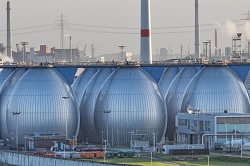Improving desalination with nanotechnology
Currently over 63 million cubic meters of water are desalinated in more than 14 000 plants globally each day. This is mainly achieved using reverse osmosis (RO), where a very dense polymer membrane allows only water molecules to pass through. But desalination using RO presents a number of environmental problems, so the NAWADES project has taken up the challenge to improve the process. The project has used nanotechnology to develop new solutions for the task. According to the Intergovernmental Panel on Climate Change (IPCC) by the year 2050, around 60 % of the world’s population could experience severe water shortages, with 33 % already under stress. Some countries are well on the way to covering their need by desalination; for example, Israel with over 40 % and Saudi Arabia with 70 % of water to its cities, coming from desalination - the process that turns salty sea-water into fresh potable water. Europe holds around 10 % of the global desalination capacity, led by Spain, with more than 700 plants in place. Even in the UK, London has opened its first desalination plant. But the current technology has problems. The waste stream generated by desaliantion using RO is one of these problems. Waste from the brine and added chemicals are usually discharged back into the sea. The overall process consumes considerable quantities of energy also. Optimal desalination using RO membranes is limited by the precipitation of bulk mineral salts, called surface scaling, and biological fouling by bacteria, both leading to shortened membrane life. ‘Continuous dosing of antiscaling agents, together with chlorination or dechlorination strategies are used to reduce scaling and fouling and the need for costly membrane replacement,’ explains Christiane Chaumette of the Fraunhofer Institute for Interfacial Engineering and Biotechnology and NAWADES project coordinator. The NAWADES project united a high-level European consortium in membrane production and application to carry out research on seawater desalination enhancement, starting at the very base: the membrane and including the complete process from seawater intake to effluent streams. The consortium used technologies including plasma surface modification of the membrane and inbuilt UV-irradiation methods that enhance the removal of biofouling of the membrane. The new desalination device was designed to be self-cleaning using an additional curved casing with LED lights. This provides light to activate a Titanium dioxide (TiO2) catalyst in either polyvinylidene fluoride (PVDF) or aluminium oxide membranes. The project also investigated fouling and scaling monitoring using electrical impedance comparisons. The LED and self-cleaning membranes were developed into demonstration prototypes and tested on-site in the pilot phase of NAWADES at the desalination plant of El Prat de Llobregat in Barcelona, Spain. Four different versions of the ultrafiltration membranes were tested during the demonstration time in both dead end and cross flow settings and with and without LED-UV irradiation. ‘Witnessing the transition from the NAWADES laboratory test through the demonstration and into a bouquet of market concepts has been a good experience. I am personally grateful that the industrial partners also permitted timely publication of several research results,’ says Chaumette. The NAWADES partners have invested in 2 patent applications, one of them granted already. The partners have signed an exploitation agreement on NAWADES technology and continue development of specific technologies in bilateral and trilateral partnerships.
Keywords
NAWADES, desalination, membrane system, seawater, reverse osmosis, fouling, scaling



